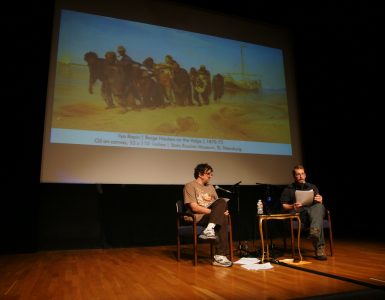This past weekend, Waziyatawin, Derrick Jensen, Lierre Keith, and I addressed a crowd of a few hundred at Occupy Oakland. You can view video of the event online.
You can also read the original text of my talk (which differs slightly from the video) below the break.
My name is Aric McBay, I’m a writer and activist from Canada. (Or rather, I come from a part of this continent belonging to the Algonquin and Mohawk peoples that is occupied by the state of Canada.)
First of all, let me say that it is an honour that you’ve had us speak here in Oakland, a place with such an amazing and strong tradition of political resistance. I have often been inspired, moved, and educated by the stories of resistance that have come from this place over many decades.
So in return, I would like to share with you a story of resistance.
It takes place here, in this country. In this story, an economic downturn has left millions of people homeless, hungry, and uncertain. After a costly war overseas, millions of veterans are in the same situation, virtually abandoned by the government they served. In response, people in cities across the country set up camps and shanty towns in protest.
I’m sure all of this sounds very familiar and current to you. But the story I’m talking about took place eighty years ago.
The Occupy movement is not the first or only time in American history that mass encampments have been set up in cities. In the early 1930s, at the dawn of the great depression, hundreds of these camps were set up across America. There were named Hoovervilles, after President Herbert Hoover, who was blamed for the depression.
The biggest of these encampments was in Washington, DC. Tens of thousands of World War I veterans moved in, demanding a veteran’s bonus that the government had promised but refused to give out. They called themselves “The Bonus Army.”
You see, the veterans had only ever done what the government had asked of them. And instead of being rewarded after the war, many of them were hungry, homeless, unable to feed their families, unable to find a job.
By the middle of 1932, close to 20,000 people (including both veterans and their families) had set up tents and makeshift shanties at a place called Anacostia Flats. It was a way of life—a baby was even born in the camp.
Their only demand was eminently reasonably—they only wanted what the government had said would—that each veteran would receive a bonus of $1 for each day they had spent overseas.
After several months, president Hoover decided that the camp had to go. He sent in police, who attacked and shot two of the protesters. But the veterans refused to leave.
So the president decided to send in the Army. The task force he sent was commanded by some people you will know: one of them was George S. Patton, later a famed tank commander. Another was Dwight Eisenhower, later the president.
When the Army arrived, the veterans cheered. They thought that their brothers in arms had come to march in support of the Veterans. But the army fixed bayonets on their rifles, put on gas masks, and charged the crowd. They used bullets, bayonets and gas canisters to drive the crowd out.
Many of the veterans were injured. A little boy was bayoneted. And that baby who was born in the camp was killed by the Army’s gas. The army drove out the veterans and then burned the camp on Anacostia Flats to the ground.
#
Of course, many of the Hoovervilles were attacked. The Hooverville in Seattle was burned down twice by the police, but people kept rebuilding. The Seattle Hooverville would last ten years.
The veterans of the Bonus Army did not just give up. But I’ll come back to them in a minute.
I study and write about resistance movements. And for a resistance movement to try to gain and occupy ground over a long period of time is extremely difficult to do. Many movements in history have tried to do this before they were ready and failed. Often it is not until they are very well established that they can resist well-organized police or soldiers and defend the territory they have claimed.
That’s why many radical movements for justice in the depression went on the offensive and used direct action and disruptive tactics. They don’t just sit and wait for the police to attack at a time convenient for the cops. They use their own mobility, initiative and surprise to put those in power off balance.
Frances Fox Piven and Richard Cloward talk about this in their classic book Poor People’s Movements: Why They Succeed, How They Fail.
At the same time as people in the depression used the defensive tactics of the Hoovervilles they used many offensive tactics as well. For example, when someone had been evicted because they couldn’t pay their rent, people come together would come together and “unevict” those families who had been kicked out. Special gas and electric squads were organized to re-hook-up the utilities of people whose services had been shut off.
If the government was not giving a family the relief services they needed to survive, people would sometimes storm and occupy relief offices until they were given the services they needed.
These tactics were often very successful, not only for families, but even when larger groups were affected. In Atlanta, around the same time as the Bonus Army was getting kicked out, the city and country governments dropped 23,000 families from the relief rolls. A mass of a thousand employed workers converged on the courthouse and forced the government to redirect funds to those families.
The book Poor People’s Movements argues that because poor people have little political leverage, they can only succeed through disruption outside of the electoral system and government bureaucracy. They win by going on the offensive. And they lose when they are coopted by those in power—when they are convinced to stop causing so much trouble, and go along with the system.
So far, the occupy movement has been very resistant to cooptation. So you’ve been avoiding one major trap that those in power use to neutralize social movements. But remember that movements only win when they can mobilize around concrete short-term goals. This is what gives people practice in resistance, it is what keeps the momentum up, it is what rallies new members to a movement.
You here in Oakland have already made progress in this direction with the blockade of the port and the general strike. So if anyone can do this, it’s you folks here.
Let’s get back to the Bonus Army and the veterans of the great depression. Four years after the camp at Anacostia Flats was burned, the government finally gave in and paid the veterans their bonus. Why did they do this? One reason, of course, was that those who organized the Hoovervilles and the Bonus Army marches never gave up. Even when they were attacked and evicted, they regrouped, they fought back, and they tried new things.
The other reason was the during the Great Depression the federal government was increasingly terrified of a revolution. When you have people storming welfare offices and reconnecting their own utilities and rallying in marches of tens of thousands it starts to look like a revolution might be imminent. So the government, then under Roosevelt, realized that the only way to head that off a revolution was to make concessions. This is why new job creation and assistance programs were created. People got concessions because the government was afraid of them. And because they never gave up.
The Hoovervilles were slowly removed as Word War Two began, partly through new job creation programs and partly through shantytown elimination programs. So they were simultaneously pushed out by the government, and evacuated by those who successfully got jobs in a growing economy.
#
It’s not going to happen the same way this time. The economy is never going to recover and grow the way it did during world war II. Capitalism is a pyramid scheme, a ponzi scheme. It can only function when it grows, when it continually expands its circle of exploitation. The problem is not a glitch in capitalism. It is capitalism itself.
And industrial capitalism is reaching the limits of its expansion. Global oil production has peaked, and the energy supply will only become tighter and more expensive. Some economists believe the recent economic downturn was the first sign of peak oil. In any case, once peak oil truly sets in, the increasing cost and decreasing supply of energy will stall industrial manufacturing and transportation, especially on a global scale. The markets will undergo economic turmoil and a self-perpetuating cycle of economic contraction will take place. Global capitalism will wither.
But this won’t happen fast enough to stop global warming. And the worst effects of global warming won’t hit until decades after the oil is gone. There is a lag effect, you see. But once it beings, it is self-perpetuating. The ice caps will melt and release huge amounts of frozen greenhouse gases. The oceans, already emptied out by industrial fishing, will turn acidic and die. The Amazon rainforest, which currently produces its own climate by transpiring moisture, will turn into a desert, and other fragmented tropical forests will follow. Growing food on a large scale will become impossible.
According to a report from the International Energy Agency this week, we have only about five years to prevent irreversible runaway global warming. And we must stop runaway global warming by whatever means we can muster. If we can’t, ecological collapse will wipe out all our other social justice gains, and wipe out any future worth living in.
This can only happen if we have a real resistance movement.
What we need is two pronged. On one hand, we need to build local, sustainable, democratic communities in which everyone’s basic needs are met. When the real crash comes we won’t be able to rely on special squads to hook people’s gas back up, because there won’t be enough gas. We have to learn how to meet our own needs.
And on the other hand we have to fight to stop global industrial capitalism. We can only win if we shut down the machine. That is the only way to ensure a livable future.
So we need is a real resistance movement. There is one such movement organizing right now, called Deep Green Resistance. People from that movement have been handing out flyers today: Occupy the machine. Please read this, and visit the website deepgreenresistance.org.
The plan in Occupy the Machine is one of the first steps in a broader strategy to save the planet. But we need concrete short-term goals to win, and we need to keep and build moment.
Tomorrow there will be an event called Earth at Risk. Seven people, including ourselves, Arundhati Roy, Thomas Linzey, and Stephanie McMillan will talk about how to build a resistance movement that can save the planet. It goes all day and starts at 10am at Wheeler Hall at UC Berkeley, and you can find out more by visiting EarthAtRisk.net.
I hope that you will join us tomorrow in Berkeley. And I hope that your general assembly will consider endorsing the statement in Occupy the Machine, and that you here in Oakland will continue to be leaders in the struggle for justice and freedom.
Because we will only win if we can fight together, for our future, and our planet.
Thank you.







